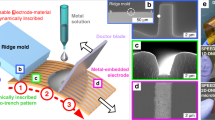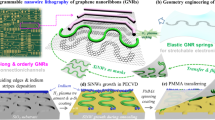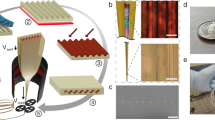Abstract
The fabrication of multifunctional nanomaterials and their subsequent use for novel applications in various branches of nanotechnology has been under intense scrutiny. Particularly in the area of nanomechanics, the design of multicomponent nanostructures with an integrated multifunctionality would enable the construction of building blocks for nanoscale analogues of macroscopic objects. Here, we introduce a new class of flexible nanostructures: metallic nanorods with polyelectrolyte hinges, synthesized using layer-by-layer electrostatic self-assembly of oppositely charged polyelectrolytes on barcode metal nanorods followed by segment-selective chemical etching. Nanorods with hinges that consist of one polyelectrolyte bilayer display considerable flexibility, but with a greater number of bilayers the flexibility of the hinge is significantly reduced. Magnetically induced bending about the polymer hinge is illustrated through the incorporation of nickel segments into the barcodes and the application of an external fluctuating magnetic field.
This is a preview of subscription content, access via your institution
Access options
Subscribe to this journal
Receive 12 print issues and online access
$259.00 per year
only $21.58 per issue
Buy this article
- Purchase on Springer Link
- Instant access to full article PDF
Prices may be subject to local taxes which are calculated during checkout




Similar content being viewed by others
References
Martin, C. R. Nanomaterials: A membrane-based synthetic approach. Science 266, 1961–1966 (1994).
Nicewarner-Pena, S. R. et al. Submicrometer metallic barcodes. Science 294, 137–141 (2001).
Reiss, B. D. et al. Electrochemical synthesis and optical readout of striped metal rods with submicron features. J. Electroanal. Chem. 522, 95–103 (2002).
Hultgren, A., Tanase, M., Chen, C. S., Meyer, G. J. & Reich, D. H. Cell manipulation using magnetic nanowires. J. Appl. Phys. 93, 7554–7556 (2003).
Lee, K.-B., Park, S. & Mirkin, C. A. Multicomponent magnetic nanorods for biomolecular separation. Angew. Chem. Int. Edn 43, 3048–3050 (2004).
Nicewarner-Pena, S. R., Carado, A. J., Shale, K. E. & Keating, C. D. Barcoded metal nanowires: optical reflectivity and patterned fluorescence. J. Phys. Chem. B 107, 7360–7367 (2003).
Tanase, M. et al. Magnetic alignment of fluorescent nanowires. Nano Lett. 1, 155–158 (2001).
Love, J. C., Urbach, A. R., Prentiss, M. G. & Whitesides, G. M. Three-dimensional self-assembly of metallic rods with submicron diameters using magnetic interactions. J. Am. Chem. Soc. 125, 12696–12697 (2003).
Qin, L., Park, S., Huang, L. & Mirkin, C. A. On-wire lithography. Science 309, 113–115 (2005).
Sioss, J. A. & Keating, C. D. Batch preparation of linear Au and Ag nanoparticle chains via wet chemistry. Nano Lett. 5, 1779–1783 (2005).
Liu, S. H., Tok, J. B. H. & Bao, Z. N. Nanowire lithography: fabricating controllable electrode gaps using Au-Ag-Au nanowires. Nano Lett. 5, 1071–1076 (2005).
Paxton, W. F. et al. Catalytic nanomotors: autonomous movement of striped nanorods. J. Am. Chem. Soc. 126, 13424–13431 (2004).
Kline, T. R., Paxton, W. F., Mallouk, T. E. & Sen, A. Catalytic nanomotors: remote-controlled atonomous movement of striped metallic nanorods. Angew. Chem. Int. Edn 44, 744–746 (2005).
Fournier-Bidoz, S., Arsenault, A. C., Manners, I. & Ozin, G. A. Synthetic self-propelled nanomotors. Chem. Commun. 441–443 (2004).
Paxton, W. F., Sen, A. & Mallouk, T. E. Motility of catalytic nanoparticles through self-generated forces. Chem. Eur. J. 11, 6462–6470 (2005).
Ozin, G. A., Manners, I., Fournier, S. B. & Arsenault, A. Dream nanomachines. Adv. Mater. 17, 3011–3018 (2005).
Petrovykh, D. Y. et al. Alkanethiols on platinum: multicomponent self-assembled monolayers. Langmuir 22, 2578–2587 (2006).
Yu, J.-S., Kim, J. Y., Lee, S., Mbindyo, J. K. N., Martin, B. R. & Mallouk, T. E. Template synthesis of polymer-insulated colloidal gold nanowires with reactive ends. Chem. Commun. 2445 (2000).
Decher, G. Fuzzy nanoassemblies: Toward layered polymeric multicomposites. Science 277, 1232–1237 (1997).
Mueller, R., Kohler, K., Weinkamer, R., Sukhorukov, G. & Fery, A. Melting of PDADMAC/PSS capsules investigated with AFM force spectroscopy. Macromolecules 38, 9766–9771 (2005).
Lobo, R. F. M., Pereira-da-Silva, M. A., Raposo, M., Faria, R. M. & Oliveira, O. N. Jr . The morphology of layer-by-layer films of polymer/polyelectrolyte studied by atomic force microscopy. Nanotechnology 14, 101–108 (2003).
Acknowledgements
G.A.O. is the Government of Canada Research Chair. He is deeply indebted to the Natural Sciences and Engineering Research Council (NSERC) of Canada for financial support for this work. A.A. and T.M. thank NSERC for graduate scholarships in support of their research. The authors wish to thank L. Cademartiri for helpful discussions.
Author information
Authors and Affiliations
Contributions
A.A. developed the original concept. A.A. and S.F. designed the experiment. M.L.F. performed the experiments on one-hinged nanorods. T.M. performed the experiment on two-hinged nanorods, analysed the brownian bending motion and incorporated the magnetic segment into the hinged barcodes. N.Z. greatly assisted in the experiments required to complete the study. All authors co-wrote the paper.
Corresponding authors
Ethics declarations
Competing interests
The authors declare no competing financial interests.
Supplementary information
Supplementary Information
Supplementary figures S1, S3, S5 and S7 + captions and supplementary movie captions (PDF 3093 kb)
Supplementary Information
Supplementary movie S2 (MOV 384 kb)
Supplementary Information
Supplementary movie S4 (MOV 241 kb)
Supplementary Information
Supplementary movie S6 (MOV 248 kb)
Supplementary Information
Supplementary movie S8 (MOV 253 kb)
Supplementary Information
Supplementary movie S9 (MOV 208 kb)
Supplementary Information
Supplementary movie S10 (MOV 876 kb)
Supplementary Information
Supplementary movie S11 (MOV 441 kb)
Supplementary Information
Supplementary movie S12 (MOV 628 kb)
Supplementary Information
Supplementary movie S13 (MOV 660 kb)
Supplementary Information
Supplementary movie S14 (MOV 71 kb)
Supplementary Information
Supplementary movie S15 (MOV 185 kb)
Rights and permissions
About this article
Cite this article
Mirkovic, T., Foo, M., Arsenault, A. et al. Hinged nanorods made using a chemical approach to flexible nanostructures. Nature Nanotech 2, 565–569 (2007). https://doi.org/10.1038/nnano.2007.250
Received:
Accepted:
Published:
Issue Date:
DOI: https://doi.org/10.1038/nnano.2007.250
This article is cited by
-
Development of micro- and nanorobotics: A review
Science China Technological Sciences (2019)
-
Programming biosensing sensitivity by controlling the dimension of nanostructured electrode
Analytical and Bioanalytical Chemistry (2019)
-
Recent progress on the design and fabrication of micromotors and their biomedical applications
Bio-Design and Manufacturing (2018)
-
Programmable self-assembly
Nature Materials (2015)
-
Coaxial lithography
Nature Nanotechnology (2015)



